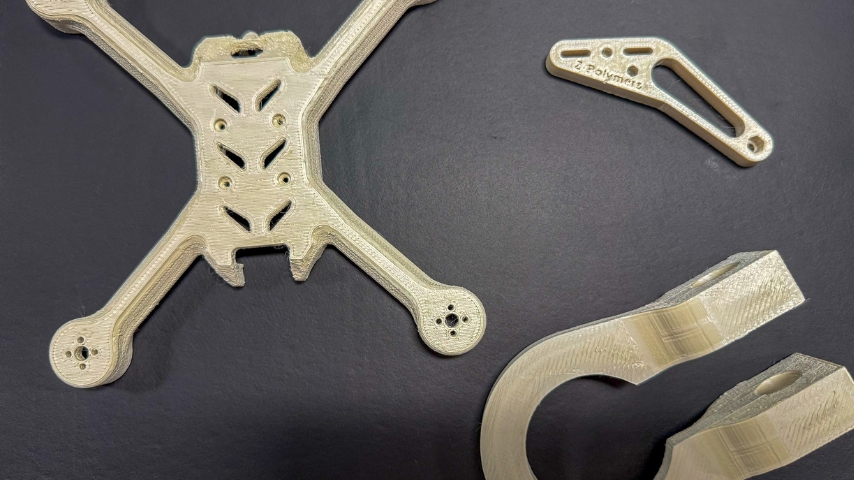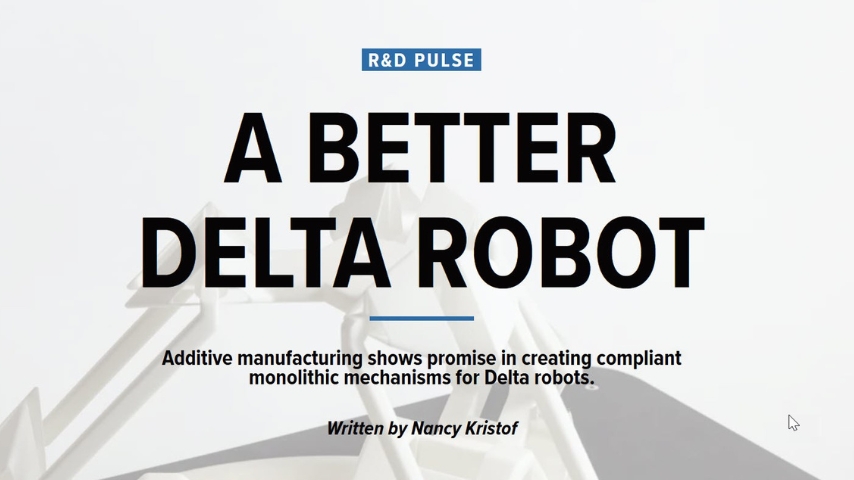Commercial Outcomes from Consumer 3D Printers
Commercial Outcomes from Consumer 3D Printers


Tullomer has so many great attributes that Mike Zimmerman, developer of the material, admitted that his biggest problem is trying to focus on only the best use cases for the super polymer.
Innovation is more likely to happen when state-of-the-art tools and materials find their way into the hands of a greater number of people. This democratization of technology increases advances exponentially because the science is not limited to a handful of elite users.
Such is the story of Z-Polymers’ Tullomer. This material allows for the printing of commercial grade materials on consumer-level 3D printers. In fact, the material has so many great attributes, Mike Zimmerman, CEO and founder of Z-Polymers who developed the substance, admitted that the company’s biggest challenge is “trying to focus on the best application for it.”
It is clear to Zimmerman that only working with a couple of hundred thousand expensive, large, high-performance machines does not stand a chance when up against the innovative power that comes with millions of users of desktop 3D printers. The professor of the practice at Tufts University in the Materials Science program teaches and advises from an industrial perspective and has developed a material with the properties of advanced materials such as polyether ketone (PEEK) and polyetherimide (Ultem).
The substance, Tullomer, is heat and chemical resistant, has mechanical strength, and is biocompatible. But what puts Zimmerman’s material ahead of the others is the simple fact that individuals are able to use an affordable, easy to use printer—like a Bambu—to achieve comparable mechanical properties to Ultem and PEEK.
“The nature of our material is that we formulated it such that you can have better mechanical properties than PEEK and it has equivalent or better properties in other areas like chemical resistance,” Zimmerman explained. For example, it is V-0 (like PEEK), and has a lower outgassing and lower dielectric properties.
Zimmerman earned his bachelor’s, master’s, and doctoral degrees in mechanical engineering and has worked in the materials field for three decades. He has watched the trends. So while others try to improve upon mechanical properties by adding fillers or introducing chopped carbon fibers and long continuous carbon fibers, Tullomer doesn’t add fill or fiber yet still has a very high strength to weight ratio. And it has many other properties such as it is non-flammable. “Actually, the surface chars into a carbonaceous layer. So it won't burn or drip,” Zimmerman explained.
He pointed to the polymer, Kevlar. The fiber can only be extruded using a solvent. It doesn't melt and is strong because of aromatic, benzene rings, Zimmerman explained. “What we have done is take a similar backbone of Kevlar and incorporated that backbone into our polymer,” he said.
“The material bonds to other long chains and making it such that it has secondary bonds that make it melt processable so we can heat it up and melt it, extrude it, and can print at a very high speed,” Zimmerman explained. The material is able to maintain its crystallinity throughout the entire process.
The startup is so optimistic about its material that it sent out an invitation for individuals to send in ideas for its uses. Four hundred individuals took up on the offer and sent in their concepts. Realistic ideas were rewarded with some of the material—free of charge. “We’re trying [different ways] to make our material available,” Zimmerman explained.
Zimmerman began his working career at Bell Laboratories and Saint-Gobain. He found that he enjoyed research that involved advanced materials and worked at Bell labs for nearly 15 years developing new polymers and processes for manufacturing. He held the title of scientific director of North America for Saint-Gobain.
Despite loving working for both of these great companies, he decided it was time to go off on his own. What he found was he was a natural when it came to running a startup—Z-Polymers is his fourth business that he started from nothing. “I feel rewarded by the sense that I've been able to develop new ideas and build a team,” he said. Not to mention, being able to secure funding, “hire people, and give them some interesting jobs.”
 Zimmerman recognizes in himself the spark that some people have and the need to push boundaries and lead innovation. There are those who are “willing to try something and take a risk,” he explained. He said that when you are involved with startups you have to have a vision of something that you want to do. “That could be what I would call a breakthrough,” he said. “And you have to basically be someone who is willing to take a risk and have it not always work out.”
Zimmerman recognizes in himself the spark that some people have and the need to push boundaries and lead innovation. There are those who are “willing to try something and take a risk,” he explained. He said that when you are involved with startups you have to have a vision of something that you want to do. “That could be what I would call a breakthrough,” he said. “And you have to basically be someone who is willing to take a risk and have it not always work out.”
As a professor at Tufts he sees this same “spark” in some of his students. “I've had several [individuals] approach me about being interns.” Zimmerman explained. “But it’s not for everybody. There are certain qualities you need to work in a startup.”
Cathy Cecere is membership content program manager.
Such is the story of Z-Polymers’ Tullomer. This material allows for the printing of commercial grade materials on consumer-level 3D printers. In fact, the material has so many great attributes, Mike Zimmerman, CEO and founder of Z-Polymers who developed the substance, admitted that the company’s biggest challenge is “trying to focus on the best application for it.”
Democratization of additive manufacturing
It is clear to Zimmerman that only working with a couple of hundred thousand expensive, large, high-performance machines does not stand a chance when up against the innovative power that comes with millions of users of desktop 3D printers. The professor of the practice at Tufts University in the Materials Science program teaches and advises from an industrial perspective and has developed a material with the properties of advanced materials such as polyether ketone (PEEK) and polyetherimide (Ultem).
The substance, Tullomer, is heat and chemical resistant, has mechanical strength, and is biocompatible. But what puts Zimmerman’s material ahead of the others is the simple fact that individuals are able to use an affordable, easy to use printer—like a Bambu—to achieve comparable mechanical properties to Ultem and PEEK.
“The nature of our material is that we formulated it such that you can have better mechanical properties than PEEK and it has equivalent or better properties in other areas like chemical resistance,” Zimmerman explained. For example, it is V-0 (like PEEK), and has a lower outgassing and lower dielectric properties.
30 years of material science
Zimmerman earned his bachelor’s, master’s, and doctoral degrees in mechanical engineering and has worked in the materials field for three decades. He has watched the trends. So while others try to improve upon mechanical properties by adding fillers or introducing chopped carbon fibers and long continuous carbon fibers, Tullomer doesn’t add fill or fiber yet still has a very high strength to weight ratio. And it has many other properties such as it is non-flammable. “Actually, the surface chars into a carbonaceous layer. So it won't burn or drip,” Zimmerman explained.
He pointed to the polymer, Kevlar. The fiber can only be extruded using a solvent. It doesn't melt and is strong because of aromatic, benzene rings, Zimmerman explained. “What we have done is take a similar backbone of Kevlar and incorporated that backbone into our polymer,” he said.
“The material bonds to other long chains and making it such that it has secondary bonds that make it melt processable so we can heat it up and melt it, extrude it, and can print at a very high speed,” Zimmerman explained. The material is able to maintain its crystallinity throughout the entire process.
The startup is so optimistic about its material that it sent out an invitation for individuals to send in ideas for its uses. Four hundred individuals took up on the offer and sent in their concepts. Realistic ideas were rewarded with some of the material—free of charge. “We’re trying [different ways] to make our material available,” Zimmerman explained.
Startup mentality
Zimmerman began his working career at Bell Laboratories and Saint-Gobain. He found that he enjoyed research that involved advanced materials and worked at Bell labs for nearly 15 years developing new polymers and processes for manufacturing. He held the title of scientific director of North America for Saint-Gobain.
Despite loving working for both of these great companies, he decided it was time to go off on his own. What he found was he was a natural when it came to running a startup—Z-Polymers is his fourth business that he started from nothing. “I feel rewarded by the sense that I've been able to develop new ideas and build a team,” he said. Not to mention, being able to secure funding, “hire people, and give them some interesting jobs.”

As a professor at Tufts he sees this same “spark” in some of his students. “I've had several [individuals] approach me about being interns.” Zimmerman explained. “But it’s not for everybody. There are certain qualities you need to work in a startup.”
Cathy Cecere is membership content program manager.


